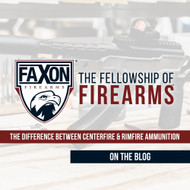The Difference Between Centerfire and Rimfire Ammunition
Posted by Faxon Firearms Staff on Jul 28th 2022
What is the Main Difference Between Centerfire and Rimfire Ammunition
A common question we get from less-experienced shooters is about the differences between centerfire and rimfire firearms and ammunition. The truth is, they’re actually both very similar, but with some key differences.
Let’s take a look at how these two different cartridge types work, the various types of each, and what those types are normally used for in the field.
Anatomy of an Ammunition Cartridge
Before we get too deep into things, it'll help if we talk about exactly what makes up your standard piece of small arms ammunition.
Starting at the business end, we have the projectile itself. The actual bullet is a chunk of metal, usually lead wrapped in copper, and is what actually travels down the barrel. A lot of people use “bullet” to refer to the whole metallic cartridge, but strictly speaking, it’s just the projectile at the end.
The bullet is seated inside the cartridge case, which is the brass or steel container that holds your powder charge, bullet, and primer all together. Inside that case, we have our smokeless powder charge (or black powder charge in much older firearms) and at the back, we have the primer compound.
That primer is what is struck by the firing pin of your firearm whenever you squeeze the trigger and is the successor to the older percussion caps of the 19th century. The primer is also what differentiates centerfire cartridges from rimfire cartridges.
The Difference Between Centerfire and Rimfire
The overall construction of centerfire and rimfire cartridges isn’t all that different. The difference really comes down to the primer that sets off the powder charge.
In a centerfire cartridge, the primer is placed in a primer pocket, which is essentially just a little circular hole in the center of the back end of the cartridge case. The primer is basically a small cup, not terribly dissimilar from the percussion caps of yesteryear.
When the firing pin strikes it, a chemical reaction initiated by the priming compounds (lead styphnate in a modern cartridge, potassium chlorate in older, corrosive primers) then sets off a little tiny explosion which then ignites the rest of the powder in the cartridge.
The resulting explosive gasses push the bullet out of the cartridge and down the barrel, and, assuming you did your part, into the target. More powder or higher pressures will send the round down the barrel, and hopefully to your target, even faster and with more energy.
With a rimfire cartridge, the same basic process occurs, except that instead of the primer being placed in a little cup in the center of the cartridge, the priming compounds are instead placed into the bottom of the cartridge, and then spun into the hollow rim.
To ignite a rimfire primer, the firing pin strikes this hollow rim, which initiates the priming reaction that sets off the firing of the bullet. From there, everything is exactly the same as it would be with a centerfire round, the only difference is the priming method and how those compounds are ignited.
Pros & Cons of Rimfire Ammo
Because of the way the primer works in a rimfire cartridge and the thickness of the brass casing, rimfire ammunition has a lower maximum pressure and subsequently lower velocity than equivalent centerfire ammunition.
For that reason, rimfire ammo is typically used for lower velocity applications like target shooting and training, and very small game hunting. Think rabbits and squirrels, small game birds (if you’re particularly skilled), and maybe the occasional pest like a snake or prairie dog.
Similarly, rimfire ammo isn’t very good at long range because it is a relatively low-velocity ammunition type, and the bullets don’t have a lot of mass to them that would allow them to carry much inertia.
The upside is that rimfire ammo is cheap to produce and purchase, and very compact and lightweight as well. A healthy adult can easily carry hundreds if not thousands of rounds of rimfire ammo very easily, making it a favorite among preppers and target shooters alike.
You can get expensive and accurate match-grade rimfire ammo, but most of what you’ll find on store shelves is cheap, bulk ammo that comes in boxes of 250-2500.
This ready availability of ammo is great for high-volume target shooters, and a number of competition sports have sprung up around rimfire calibers, such as NRL22 and various steel-shooting leagues.
There are some downsides, however. Rimfire ammo isn’t reloadable really, and you have to be careful when dry firing a rimfire gun. If you don’t use a special training round, empty cartridge, or snap cap, the firing pin will strike and possibly damage the chamber of your firearm.
Types of Rimfire Ammo and Their Uses
There are a fairly limited number of rimfire calibers on the market still today, but many of them are still extremely popular, especially the .22LR (which might be the most popular round on the planet by numbers produced). Some examples include:
.22 Long Rifle (.22LR): The king of rimfire calibers, the .22LR is incredibly versatile for varmint hunters, target shooters, and general firearm enthusiasts the world over.
Click Here to view Faxon's products for 10/22 Rimfire!
.22 Winchester Magnum Rimfire (.22 WMR): Designed to be a replacement for the .22 LR, this more powerful little cartridge is capable of taking small game at longer distances and even has some self-defense applications for those who are recoil sensitive.
.17 Hornady Magnum Rimfire (.17HMR): A newer (relatively speaking) rimfire cartridge with a little more energy than the .22LR, perfect for varmint hunting and longer-ranged rimfire target shooting.
Pros & Cons of Centerfire Ammo
Centerfire ammo can handle much larger and more powerful powder charges than rimfire ammo, which means it can handle larger projectiles, and propel them at a much higher velocity.
For hunting, self-defense, and long-range shooting, having larger projectiles moving faster means more energy to penetrate the target, and more energy to fight the effects of air resistance, gravity, and the movement of the wind.
This results in much better performance when the bullet strikes soft tissue, as well as a much easier time for the shooter actually getting the bullet to go where they want it to.
The downside is that the extra material that goes into a centerfire round costs and weighs more. There’s just more material there, so the simple economics and physics of the situation tend to work against you a little bit.
Carrying thousands of rounds of centerfire ammo, even something relatively small and light like .223 Remington or 9mm, is a difficult undertaking. There’s a reason why combat loads for military service people are usually a few hundred rounds at most.
Your typical civilian shooter will also be paying a lot more for their ammo, which makes blasting away at tin cans a bit more of a daunting prospect financially speaking. Centerfire firearms also have to handle the higher pressures, so they have to be built stronger as well.
Which, as you probably can guess, makes centerfire firearms much more expensive than rimfire firearms.
For most shooters though, the extra expense is worth it, especially if we’re talking about hunting or self-defense, or any other firearms application where muzzle velocity and transferring maximum energy to the target are important.
Finally, centerfire ammo can be reloaded or hand-loaded by the end user, so with some basic equipment and a reloading manual (basically a recipe book for ammunition), you can whip up rounds of your very own that are tailored specifically to your gun and your specific needs.
This is a huge advantage over rimfire rounds which can’t really be customized in any way or reloaded. Some of the most popular cartridges out there right now actually came from experimentation done by enthusiasts and were then picked up by major manufacturers.
Types of Centerfire Ammo and Their Uses
There is a huge number of centerfire calibers out there today to choose from, with more being released by ammo manufacturers all the time. Here are some of the most popular ones around.
9x19mm Luger (or Parabellum): The most popular handgun cartridge on the planet, used by NATO and other Western Militaries and concealed carriers alike.
.223 Remington: Incredibly widely-used intermediate cartridge, and the basis for the 5.56x45mm NATO used by US and allied militaries.
.308 Winchester: Incredibly popular hunting and target cartridge, also the basis for most military and police sniper rifles in Western countries.
.50 BMG: Anti-material round used around the world to put large holes in metal and concrete.

